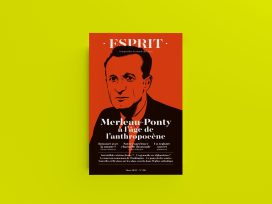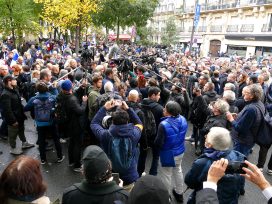Abstracts Esprit 6/2006
Jean-Pierre Peyroulou
Pardon in Algeria: When government reappoints itself without any sanction
Launched in the aftermath of Abdelaziz Bouteflika’s re-election as president of Algeria, a process is nearing completion whereby all the crimes that had been perpetrated in the civil war between the government and Islamic radicals are being pardoned. However, the pardon is not matched by any political transition and so far has only reinforced the government’s tight focus on security.
Olivier Mongin
On Iran’s tougher stance
How can we understand the strategy of Iran’s president Mahmoud Ahmadinejad with regard to nuclear power and the tougher stance against the country’s intellectuals as exemplified by the arrest of our friend Ramin Jahanbegloo? With the support of Supreme Leader Ayatollah Khomenei, the new president has shifted his ground closer to the “hardliners” of the early Khomeinei-led revolution and to veterans of the Iran-Iraq war. Nevertheless, he is also looking to reinforce what has so far been his weak grip on power as he radicalizes the diplomatic wrangling over his country’s nuclear power and turns it into a regional issue.
Jean-François Bayart
What if Europe was missing the point about Iran?
While hawks in the USA, and in Europe, too, argue in favour of a military type of response beyond sanctions and embargo against Iran, Jean-François Bayart calls on the warmongers to keep in mind the strategic mistakes and the obfuscation that preceded the war on Iraq. In this perspective, he reviews those lines of reasoning that are least susceptible to respond with a new war to Iran’s heightened challenge.
Marc Lazar
Italy takes stock of the Berlusconi years
Finally voted out of power after implementing his platform for over five years, Berlusconi did not just coalesce against himself a political movement that ranges from the centre to the radical left wing. He leaves behind a deeply split country that combines a better fit within the global economy and a weaker position in European affairs.
An interview with Joseph Maïla
The future of Catholic higher education
One year after his forced resignation, the former head of the Institut Catholique in Paris reviews the position of Catholic faculties in French higher education and the potential for expansion that comes with academic linkages in Europe – except, that is, if the faculties are to shift their focus to a confessional agenda that seems unlikely to lead them anywhere.
Stéphane Breton
You brought us the body
The new museum to be inaugurated in June 2006 in Paris focuses not just on first nations’ art but also takes in contemporary creation and the anthropological interpretation of non-European cultures. Witness to this is the theme of the first temporary exhibition, “What is a body?”, the introduction to which is reproduced here. The exhibition takes a deliberate comparative stance as it puts into perspective West Africa, New Guinea, the Amazon, and western Europe.
Rémi Astruc
Tinkering with history. About Philip Roth’s The Plot against America
Charles Lindbergh, the flying legend, was an isolationist and as such became Hitler’s main advocate in the US. What might have happened had he been elected to the presidency instead of Roosevelt? Based on this fictional political plot, the American author re-writes history while leaving it to the reader to pick up any hints at contemporary US politics. But then, why should fictional liberty lead one to imagine a persecution that never took place on American soil, a lapse that only happened in some unreal past?
An interview with Patrick Mignon and Christophe Pettiti
Sport and the law: How do we enforce law in the stadium?
The Football World Cup in Germany once again raises the issue of law enforcement around and inside sports grounds. Over the past decade, the methods for doing this have adapted to new forms of supporter behaviour, racism, and violence. A comparison between the various law enforcement schemes in Europe shows that respective attitudes to football cannot be disassociated from the relationship which every society maintains with its own violence.
Benoît Chantre
Introduction. The broadcasting angel
Daniel Arasse, who died in December 2003, knew how to make a wider public share his passion for painting, as he did in summer 2003 through a string of radio broadcasts. He was also adept at changing approaches to pictures that are so familiar that we can no longer see anything in them. Positing himself neither too close to, nor too far away from, art works, between erudite comment and plain observation, he managed to strike the right distance and watch pictures “rise” before his eyes.
Bertrand Rougé
The thinking behind painting
Daniel Arasse was keen on a “close up” history of painting, one that uncovers painted details that were not meant to be seen and, as a result, provides an intimate view of any picture. Beyond the way a picture has been executed, this approach also uncovers the thinking behind the painting, and the way an artist’s thoughts take shape through a picture.
Bruno-Nassim Aboudrar
Daniel Arasse, ways of looking and history
An erudite scholar himself, Arasse kept querying historians’ methods, their positivist attitudes, and the role of the narrative. In his books, it is the way of looking that triggers historical enquiry, because he allows himself to be surprised by the discovery of what is visible and is already there, only waiting to be seen.
Véronique Goudinoux
Questions about contemporary art: Cindy Sherman
A reputed Renaissance scholar, Daniel Arasse went out of his way to write about contemporary artists in a bid to determine whether classical notions were relevant to their work. This is how he came to comment on Cindy Sherman’s photographs, starting from the theme of “wounded Narcissus” to write about her portraits of contemporary woman.
Thierry de Duve
On a detail by Manet
Adopting Daniel Arasse’s approach, a specialist in the theory of art focuses on a detail in Un bar aux Folies-Bergère: the inconsistency between the figures up front and their reflection in the mirror at the back, which cannot be fortuitous. What does this tell us about Manet’s art?
Daniel Arasse
“Montanus fingebat”: On a crossing-out by Montaigne
This study of a detail in the Essays – a change in the date of the “address to the reader” – is a good illustration of Arasse’s approach and style. Montaigne’s intention was to “depict” himself. But then what significance should one ascribe to this pictorial and plastic reference in a reflective description of his handwriting?
Published 16 June 2006
Original in French
Contributed by Esprit © Esprit
PDF/PRINTNewsletter
Subscribe to know what’s worth thinking about.



